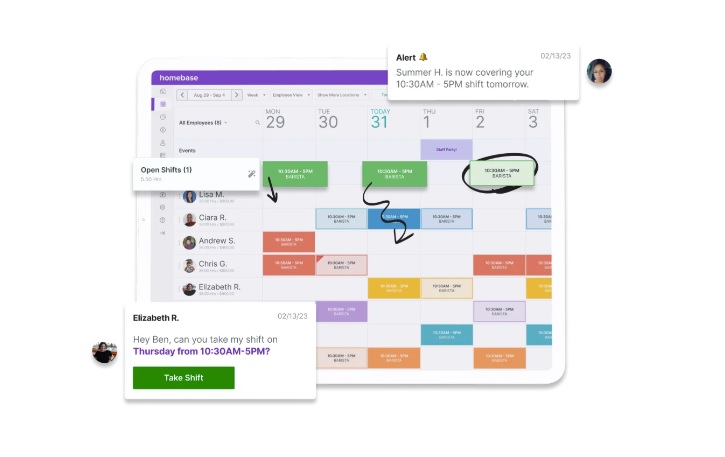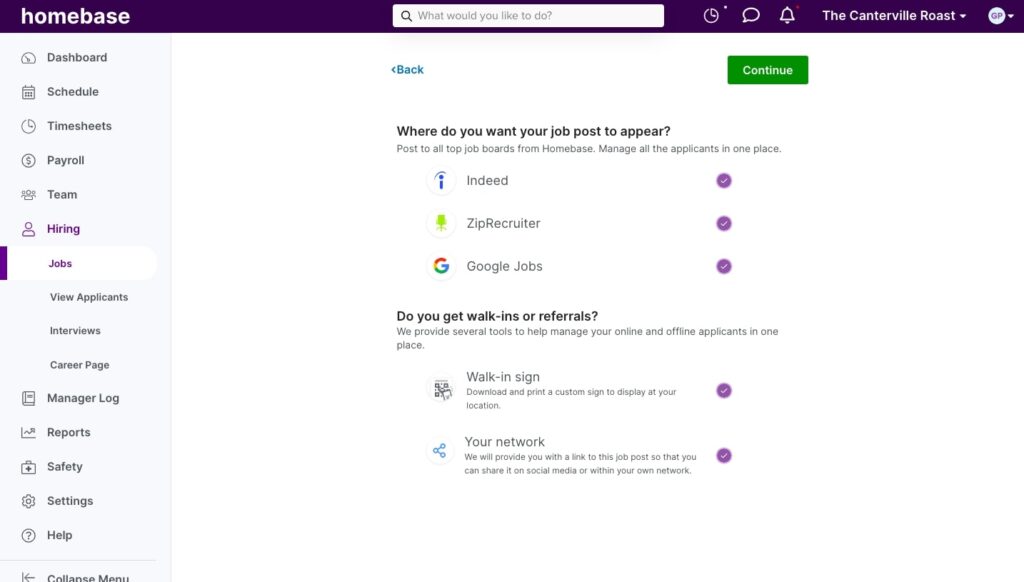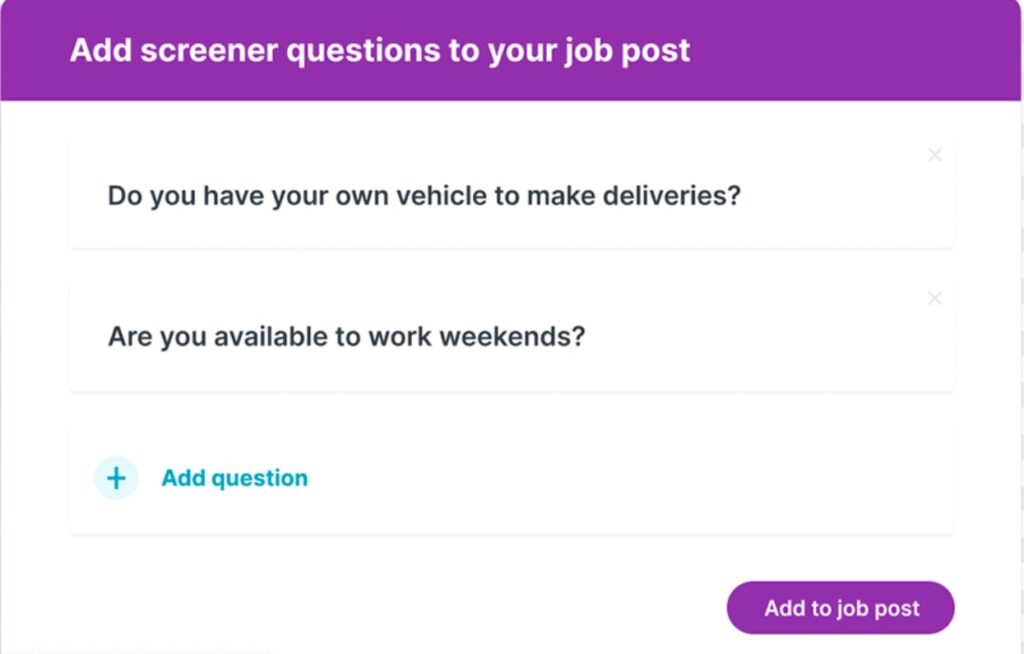Successfully sourcing and hiring seasonal employees isn’t just about filling gaps in your workforce; it’s about finding people who amplify your business’s strengths. The challenge of seasonal employment, often underestimated, lies in quickly building a quality team and adhering to company and industry standards.
For retail stores, restaurants, or delivery services, seasonal hiring is essential to manage increased workloads, ensure customer satisfaction, and maintain profitability.
Before hiring, you must understand the essentials of seasonal employment and relevant employment laws and establish an effective management strategy for your temporary staff.
In this guide, we’ll share actionable strategies and practical insights to make your seasonal hiring process manageable and successful. We’ll also show you how Homebase can help you with the hiring and onboarding process, confronting high-demand periods.
What is seasonal hiring?
Seasonal hiring is recruiting temporary workers to meet specific needs during peak times of the year. This includes businesses like ski resorts operating only part of the year or retailers needing extra help during the holiday shopping season.
Typically, these jobs range from part-time to some full-time roles, lasting a few weeks to several months, excluding year-round positions. Seasonal roles can provide unemployed individuals with temporary income, extra earning opportunities for those with other jobs, and experience for future permanent positions.
Legally, employers must follow the Fair Labor Standards Act, ensuring minimum wage and overtime pay for seasonal employees (more on this later).
Importance of strategic seasonal hiring
Effective seasonal employment is more than just filling positions; it’s a strategic move that can significantly impact your business. Here’s why:
- Cost efficiency: By hiring seasonal staff, you avoid the financial strain of year-round salaries and benefits for roles only necessary during peak periods.
- Flexibility and adaptability: Seasonal hiring allows you to quickly adapt your workforce to changing business needs, ensuring agility during high-demand periods.
- Talent pool expansion: This hiring strategy allows access to a broader range of applicants, such as students seeking summer jobs or retirees looking for short-term engagements. These groups often bring unique skills and flexibility.
- Testing ground for permanent hiring: Seasonal roles offer a risk-free way to evaluate potential employees for permanent positions, helping you identify top performers.
- Customer experience: Adequate staffing during busy seasons ensures customer service doesn’t suffer due to understaffing, directly impacting retention and building loyalty.
7 steps to create an effective seasonal employment strategy
Preparing for the seasonal rush in business isn’t just about stocking up inventory; it’s also about strategically staffing your team. Follow these steps to transform this hectic period into a smooth, profitable experience:
1. Plan in advance
Effective planning for seasonal hiring hinges on two critical activities: analyzing past sales/demand patterns and forecasting staffing needs.
Start by examining your previous seasonal sales data. For example, let’s say your retail store might notice a 40% sales increase every November and December. Then, translate these insights into your staffing strategy. If sales data predicts a 40% increase in demand, consider increasing your staff by a similar percentage, especially in key areas like customer service and inventory management.
Forecasting your staffing needs also involves budget considerations. Align your anticipated revenue increase with the costs of hiring additional staff, ensuring profitability is maintained. For instance, if you expect a $100,000 revenue boost, allocate a portion of this – say, $20,000 – for additional staffing, taking care not to erode your profit margins.
Homebase’s employee scheduling tool reduces these kinds of scheduling challenges. This feature can work with your point-of-sale system, predict when your busiest times will be based on past data, and let you schedule staff for those periods. You can also add annotations or notes to give more context to the data.

2. Develop a seasonal worker pipeline and prioritize returning candidates
Focus on individuals likely to seek short-term employment repeatedly. For example, college students often look for summer jobs and can return for several seasons. Consider prioritizing returning workers who require less training and better understand your business.
For example, a barista who worked last summer can immediately handle the espresso machine and customer service, saving time and training resources. Keep in touch with these workers throughout the year, offering them an early selection of shifts or small bonuses as incentives to return.
3. Create a clear job description for seasonal work
Once you know what you’re looking for, it’s time to write your job post. We recommend following this structure:
- About the business: Start by briefly introducing your business’s history, mission, and values. This sets the tone and aligns candidates with your culture.
- Job title: Use a specific and informative title, like “Seasonal Barista: Latte Art Proficiency Preferred.”
- Job summary: Describe what makes the role exciting. For instance, mention opportunities for gaining unique skills or experiences, such as customer interaction or using specific software.
- Responsibilities: Detail the tasks with clarity. Avoid vague terms like “handle orders”; instead, specify “Process customer orders using [Specific Inventory Management Software].”
- Skills and experience: List both required and preferred qualifications, including essential soft skills like communication and teamwork.
- Wages, benefits, and perks: Be transparent about compensation. Include any additional benefits or perks, such as early access to extended medical coverage, discounts, or flexible scheduling.
4. Ramping Up Recruiting with diverse channels
Employee a mix of channels to reach a diverse pool of candidates. Here are a few ways to find the right fit:
- Create a careers page on your website: This should showcase your company’s history, values, and culture, possibly including a welcome video. Ensure that your job postings on external sites link back to this page for detailed information about your business.
- Post to job boards: Use platforms like Indeed, Glassdoor, and ZipRecruiter to reach a broader audience. Or let Homebase hiring post it to multiple job boards simultaneously for you.

- Local outreach: Collaborate with local educational institutions and career centers. Attending or participating in local job fairs specific to your industry can also be a fruitful strategy.
- Leverage social media: Use platforms like Facebook, Instagram, and LinkedIn to connect with potential candidates. Share job openings and insights into working at your business, directing followers to your careers page for more information.
5. Screen and interview candidates
Start by setting clear criteria for what makes an ideal candidate for your business. During interviews, focus on specific questions that assess their suitability for the role, including availability, flexibility, and relevant experience.

With Homebase, you can set pre-employment screening questions, such as availability during specific hours or willingness to work evenings and weekends.
Applicants’ responses are automatically organized on the Manage Applicants page, enabling you to efficiently categorize candidates based on their suitability.
You can also filter applicants by role, location, and proximity, streamlining the process of identifying the best fit for your business needs.
6. Set up Efficient Onboarding processes
To avoid wasting valuable work time, initiate seasonal employee onboarding and paperwork before their first day. This involves completing necessary training or submitting certifications in advance. This is where a tool like Homebase’s hiring and onboarding feature comes in handy.
With Homebase, you can have seasonal employees electronically fill out and sign important documents such as direct deposit forms, W-4, W-9, and I-9, all using e-signature tools. This approach not only saves time but also ensures compliance and organization. Homebase securely stores these documents, simplifying record-keeping and ensuring a smooth transition for your seasonal staff.
7. Set Clear Employment Terms
Specify the start and end dates of employment in the offer letter, and clarify whether there are opportunities for extension or permanent roles. It’s also important to be upfront about compensation, including any potential for overtime pay.
You can compile a welcome packet with Homebase that includes documents like information about your business, policies, or training materials. You can also create a custom employee handbook with your mission statement, workplace procedures and employee rights. This approach ensures transparency, aligns expectations, and fosters a well-informed and efficient seasonal workforce.
Simplify seasonal employment with Homebase
Onboarding seasonal employees is more than a task; it’s an integral part of your business strategy, especially when you have limited resources. A well-structured onboarding process, supported by tools like Homebase, significantly eases the challenges of managing seasonal hires.
Homebase’s hiring and onboarding features can help you with initial paperwork and organize schedules effectively, fostering strong team communication and community. Our free time clock also allows for easy tracking of seasonal employees’ hours and managing labor costs.
Homebase also lets you set up communication alerts to avoid staff accidentally rolling into expensive overtime and send team members reminders to take their breaks and clock out of work on time so you avoid extensive rounding. Our platform also has employee happiness tools to boost staff engagement further.
With the right strategies and tools, every seasonal employee becomes a stepping stone to greater productivity and a more vibrant, committed workplace culture.
